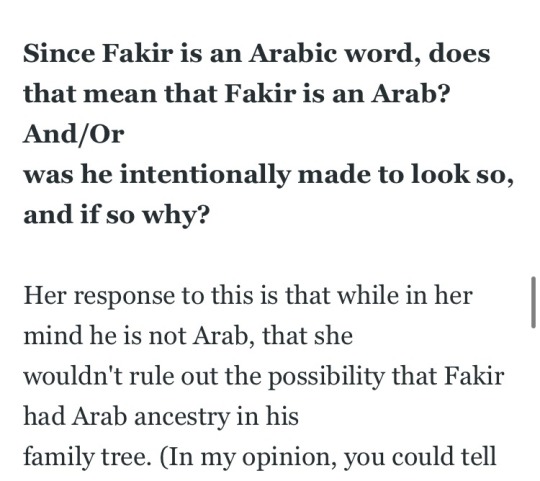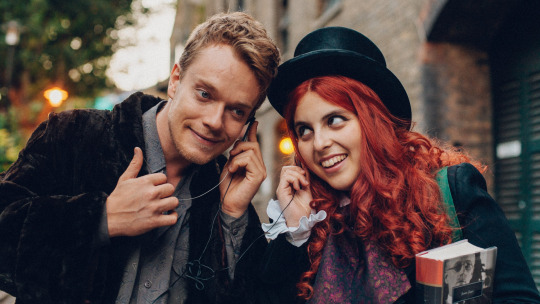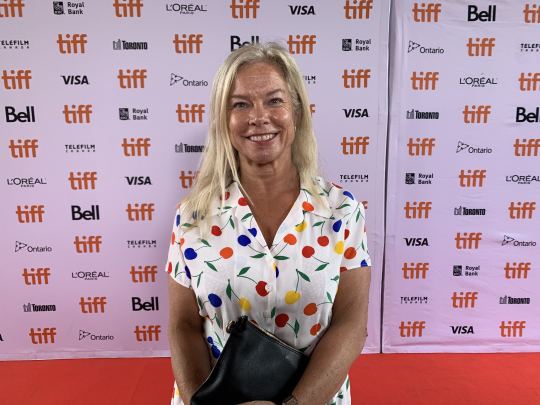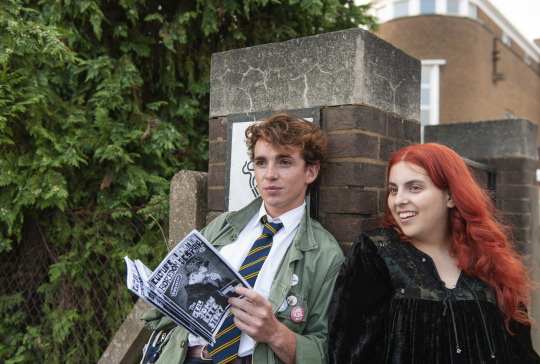#I’m sure someone can articulate the ick much better than I can
Explore tagged Tumblr posts
Text
It is my god given mission to NOT draw fakir as a white boy idc what’s canon, this interview annoys me so bad

[ID: rough transcript of an interview with Ikuko Itoh. Someone asks “since fakir is an Arabic word, does that mean fakir is Arab and/or was he intentionally made to look so, and if so why?” The transcriber writes “her response to this is that while in her mind he is not Arab, she wouldn’t rule out the possibility that fakir has Arab ancestry in his family tree”]
WHY’D YOU GIVE HIM AN ARABIC NAME THEN?? It’s okay mr fakir I won’t let her whitewash you
#that one Reddit thread that’s like my friends want to name their white baby jungkook#maybe there’s an argument for him being named after an Arabic word rather than a proper common name BUT#I did my research and all instances I can find of fakir being used as a first name are middle eastern or south Asian men#hmmmmm ����🤔#tho disclaimer I’m white so I’m not the person to be complaining about this#I’m sure someone can articulate the ick much better than I can#or maybe I’m complaining about nothing who knows ¯\_(ツ)_/¯#anyways when I draw fakir he’s Arab btw#like mixed ig because drossy is in there somewhere#princess tutu#like urghhhh the vibes I get are that she chose the name because she thinks it’s cool and mysterious but I’m like. GIRL#ITS AN ARABIC NAME
45 notes
·
View notes
Photo

Lady Sex Pirate.
Rising star Beanie Feldstein, author Caitlin Moran and producer Alison Owen talk about bringing Moran’s semi-autobiographical novel How to Build a Girl to the screen. The coming-of-age comedy, set amidst the early-90s Britpop scene, landed virtually at IFC Films this month.
In How to Build a Girl, Beanie Feldstein (Lady Bird, Booksmart) plays Johanna Morrigan, a working-class teen from Wolverhampton confident that she’s destined for greater things. Johanna blags her way into a job as a music critic, gives herself the pseudonym ‘Dolly Wilde’, and has a quick rise to infamy by finding ever more creative ways to trash the music and musicians she’s reviewing.
Johanna hits the ropes when her monstrous alter ego causes problems at work and pain for her family. One cringeworthy moment sees her slinging insults at her parents and beloved brother, like ��See how you manage without me, Ringo, Ringo and Ringo. F—k you all.”
Directed by Coky Giedroyc and also starring Paddy Considine, Chris O’Dowd, Emma Thompson and some “good Alfie Allen representation”, How to Build a Girl is really Beanie Feldstein’s show. She carries the sex-positive portrait of an ambitious young woman in the early-90s London music scene; a time before social media, when all-powerful British music magazines could anoint legends or kill a career with a single one-paragraph review.
As a statement on cultural criticism, writes Gavin on Letterboxd, How To Build a Girl “takes a crop of the media’s most hated contributors—critics—and then chisels away at them with maniacal and sometimes savage satire”. Johanna’s attempts to break into the media boys’ club, CinemaBabel writes, “is sure to resonate with many young women [who] have found themselves with the attention from those they’ve craved, especially men, only to find themselves hollower and [more] alone than they ever were at their lowest point”. Siobhan agrees, writing that the film is “perfect for girls who spent their years dreaming about getting out of the suburbs for something bigger and better���.
As is the way with adaptations, some aspects of the novel get short shrift in the film (Johanna’s home life, the collateral damage she leaves in her wake). For some, there’s also an ick-factor in seeing a sixteen-year-old shagging older blokes in the current #MeToo context, but that is part of the point Caitlin Moran is making. The film is set in 1993—long before #TimesUp—and Johanna’s workmates are intended to come off as “a bunch of creeps”.
At the film’s TIFF premiere last year, Letterboxd’s editor-in-chief Gemma Gracewood met up with the creative team for a chat about bringing the novel—the first in a trilogy about Johanna Morrigan’s adventures in music and love—to life.

Beanie Feldstein as Johanna Morrigan as Dolly Wilde, with her rock critic colleagues.
There’s so much love for Booksmart and Lady Bird on Letterboxd. What will fans of those films enjoy about How to Build a Girl? Beanie Feldstein: Oh, it’s such a beautiful coming-of-age story about a girl that’s never had that story told before. Obviously it’s loosely based on Caitlin’s life and she is literally my feminist hero! I mean, she’s like my aunt or sister at this point but I still shake around her because I just love her so much.
Truly, the way she extends a hand out to young women and says “I’ve got you and I’ve been there and you can own your experience, whatever that experience may be, and that is beautiful” is so special. It was the biggest honor of my life, and the biggest challenge too. Because I’m not from Wolverhampton, England, and I’ve never, you know, walked out in a bikini made of trash bags before!
It’s really the most beautiful coming-of-age story. So much heart, so much humor, and really touching at moments in a way that I think is unexpected. And it’s really sort of three different movies in one: you have the beautiful family story, you have all the boys at the magazine workplace, and then you have John Kite [played by Alfie Allen], and it just sweeps you off your feet as an audience member.
You are making films that so many girls get to experience as part of their own coming of age. What films did you love, growing up? BF: I grew up obsessed with Funny Girl. Fanny Brice is my idol! But there’s so many that I cherish. Bridesmaids, my senior year of high school, was, like, the best movie ever. It was the most memorable theater-going experience of my life. But what I love about How to Build a Girl is that I’ve done so many films about friendship, which I love and cherish and is so important to me, but I feel like it was really interesting to explore what happens when a girl doesn’t have friends at that time in her life. I feel like that’s also a very important story, because not everyone has those people. Not everyone’s lucky enough to find their Lady Bird or their Amy, and so it was very special for me—and also very scary, I’m out here alone!
If there’s to be a film trilogy, are you in? BF: Of course! I mean, she’s my girl! I feel so protective of Johanna and I love her so much.

Caitlin Moran with Beanie Feldstein (left) at the ‘How to Build a Girl’ red carpet at TIFF 2019.
It’s so powerful to see the sex-positivity in How To Build a Girl. It feels like we’re finally getting a run of films that show young, female sexuality in a positive light, rather than as a force of darkness. Caitlin Moran: Well that was the key thing! I just felt that every film that I’d watched that was about female sexuality was like, the women would be punished for it. Like, you either get bummed over some bins or you just regret it or it just becomes very sour. I just wanted to see a girl who’s in control of her sexuality, who’s curious, who wants to go out and have sex adventures. She’s a ‘lady sex pirate’, that’s her whole thing. She just wants to go out and have adventures and gather her memories. Beanie looks incredible in this. You’ve never seen a girl that looks like Beanie, wearing her clothes and owning her sexuality and owning her physicality. It’s joyful in every single way. It makes my heart sing.
The soundtrack is soaked in 90s bangers. Did the songs make it to the soundtrack because you insisted they be in there? Did you personally ask the artists for their permission? CM: Oh, absolutely. We wrote the whole script with all the music cues in it and 90 percent of those are in [the film]. It’s set in 1993 in London, so it’s an incredibly exciting time for rock’n’roll. We’ve got Elastica in there, we’ve got Happy Mondays, Primal Scream, Manic Street Preachers—this big rush of music.
And then John Kite is a singer-songwriter, and a very talented one. And we were like, “Oh my god, we’re going to have to get songs for him to sing!” And so I rang my friend Guy Garvey from Elbow and said, “Could you write us a song?” And he wrote us a song called ‘Day-Making Girl’, which, on his first day on set, Alfie had to sing a capella to a thousand people and absolutely nailed it in one. So it turns out Lily Allen isn’t the only rock star in that family. He sings like an angel!
You’ve written newspaper columns, books of essays, novels, and now your first screenplay (with John Niven). Which screenwriters’ work have you loved through the years? CM: Oh my gosh. Who do I really love? If you read the scripts of Bruce Robinson, who did Withnail and I, and How to get Ahead in Advertising, those scripts read beautifully. If you actually read them as scripts, all the description is there, he describes the sky looking the color of burnt sugar, and that’s someone who’s really enjoying writing and you feel that vivacity come through on the page and in the character of Withnail, so I love Bruce Robinson’s scripts.
More recently, who do I love? Juno was my favorite film of the last ten years—just the way that that story was told just made me incredibly happy. I just love Diablo Cody so much. When you read her stuff you feel her heart, sometimes her groin! And her massively exploding soul! So that’s what I’m always looking for. I just want to see things on screen that look real, that someone went, “I’m going to have to write this or bust.” I hate films that look like someone went, “Oh, we’d better make a film that looks like a film.” I want people to have sat down and done a list of things where they’re like, “What would I like to see on screen that I’ve never seen before?”
And that’s what we tried to do with How to Build a Girl. When I was writing the book, it was just a list of things that I’d never heard anybody talk about with girls. At the time that was, like, masturbation, sexual experimentation, optimism, confidence, being working class and making your way up from scratch. Finding a rock star that isn’t a clichéd druggy rock star. He’s actually a good, working-class boy who becomes a great friend. I’ve never seen that. Usually if a rock star character turns up in a film or a book, they’re going to be a bad ’un. And in our John Kite, he’s just a good boy and a friend. So yeah, I just ticked everything off both with the book and the film: “Yeah, we’ve done all these things.”

Producer Alison Owen.
What was the moment you knew you had to option Caitlin’s novel? Alison Owen: When I read her first book [of essays], which was How to Be a Woman, for me it was like the freaking Bible or something. Caitlin’s writing is every argument I’ve ever had with anyone at dinner or at a party. I thought, ‘If I just carry this book around with me the whole time, every time I have a row with someone about feminism I can pull it out and I can just quote it to them and I’ll have the answers.’ She’s much more articulate and intelligent than me!
But of course How to Be a Woman was quite tricky as a conversion into a film or a television series as it’s more of a how-to manual than it is a story. So I was really excited about How to Build a Girl because there’s a real story there. It’s got a spine and a shape that you can make into a movie. So I was like, yes, that’s the one we’re going to do.
The moment I read How to Build a Girl, I wanted to option it, but that was already optioned. And then by the time her second one came out [How To Be Famous], the option on that first one had lapsed, and so I scooped in and optioned all of them.

Laurie Kynaston (as Krissie Morrigan) and Beanie Feldstein (as Johanna Morrigan) read Laurie’s zine, featuring cover star Alfie Allen (as 90s heartthrob John Kite).
Did you always imagine the very Californian Beanie Feldstein as the one to play this teenager from Wolverhampton? AO: Well that was crazy. Obviously, we assumed we would be on a kind of street search, because we knew we weren’t going to find a ‘name’ to play a sixteen-year-old girl from Wolverhampton. Shaheen Baig, our casting director, was doing workshops and street casting and open casting and casting calls and this was all going on and we kept finding really good people, but nobody that would hold a movie for 100 minutes.
And then, I am on the board of the Savannah Film Festival. I went to Savannah and there was an early screening of Lady Bird, and the second I came out of that cinema I called Coky and I was like, “I found Johanna!” And she was like “What do you mean? We’re trying to cast a sixteen-year-old from Wolverhampton! You’re trying to cast a 25-year-old girl from California? What are you talking about?!” I said, “Just wait till you see it. She’s Johanna.”
We got Beanie to Skype with Coky, and Coky was bowled away straight away. She really just has all the qualities of Johanna. That kind of boundless joy and optimism and wonder that you need from that character. She’s got to be quite horrible, so you need someone who is innately likeable so that you don’t go off her at that point. You’ve got to keep hold of that washing line all through that movie.
How to Build a Girl is all about a young woman discovering who she is, both professionally and personally. With your abundant screen credits, what advice do you have for young women wanting to step up into producing? AO: I think just believe in yourself and be tenacious. You know, it’s such a young industry. That’s what I always say when I speak to students or young people and they’re like, “How do I ever get to do what you do?” I’m like, “You’re much better placed to do it than I am! I’m 58! Nobody wants me anymore!” You guys, you know what you’re watching and what all your friends are watching and the things that are going to turn you on. Believe in those, because that’s what’s going to sell. It’s a market.
Related content
Teenage Wasteland: A Comprehensive List of Coming-of-Age Films
Vanessa’s Bumper List of Films Directed by Women
The Official Letterboxd Top 100 Films Directed by Women
‘How to Build a Girl’ is available in the US now via IFC Films.
#beanie feldstein#how to build a girl#caitlin moran#lady bird#booksmart#britpop#alfie allen#emma thompson#paddy considine#chris o'dowd#nme#music criticism#rock critic#criticism#directed by women#female director#52 films by women#52 films#early 90s#1990s style#dolly wilde#lady sex pirate#fans of letterboxd#tiff#tiff 2019#letterboxd
10 notes
·
View notes